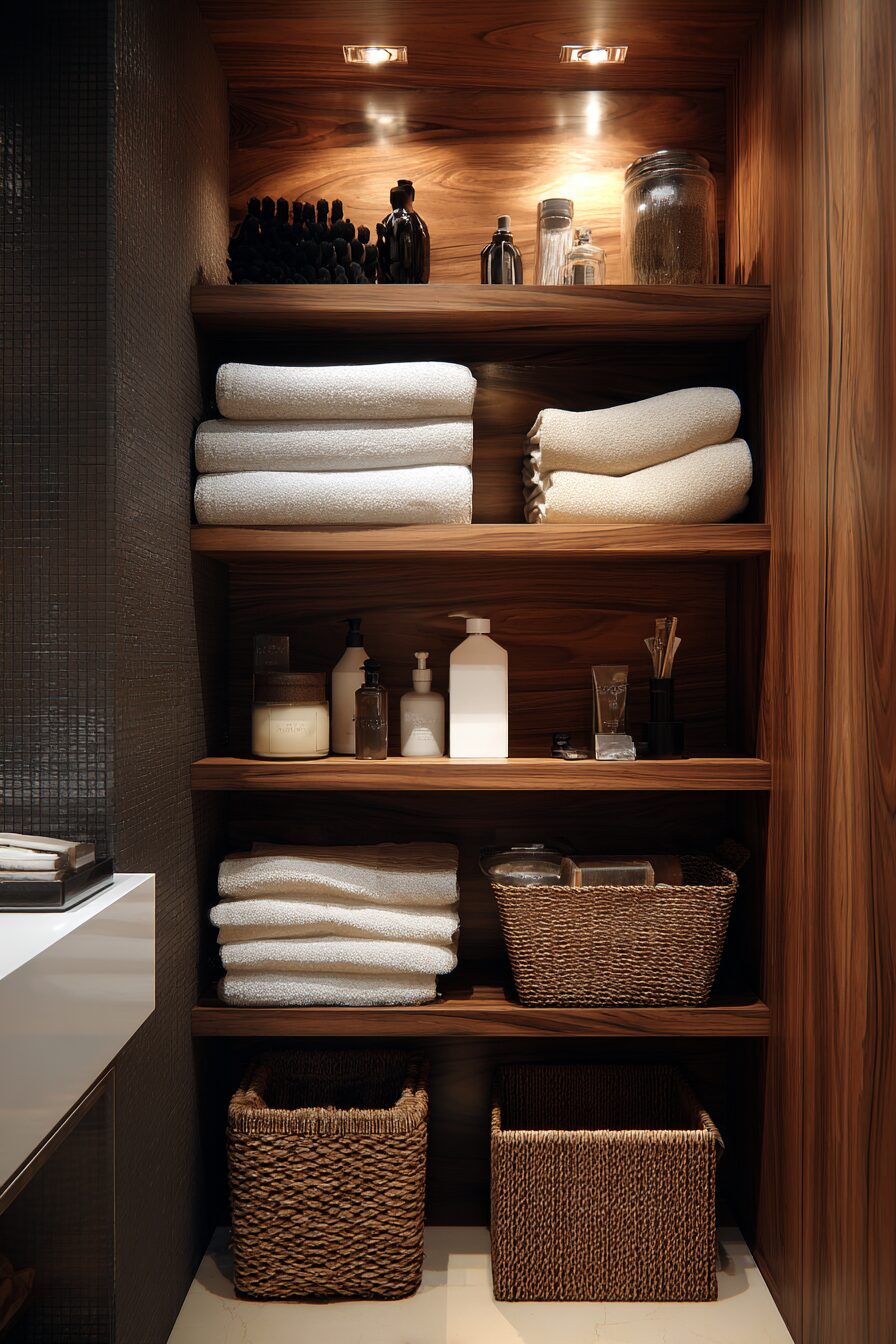Decluttering doesn’t have to feel like climbing Mount Everest in flip-flops.
If you’re downsizing, preparing for a move, or simply tired of navigating around stacks of “someday” items, these practical tips will help you reclaim your space without the overwhelm.
Start With Your Bathroom – The Quick Win That Builds Momentum
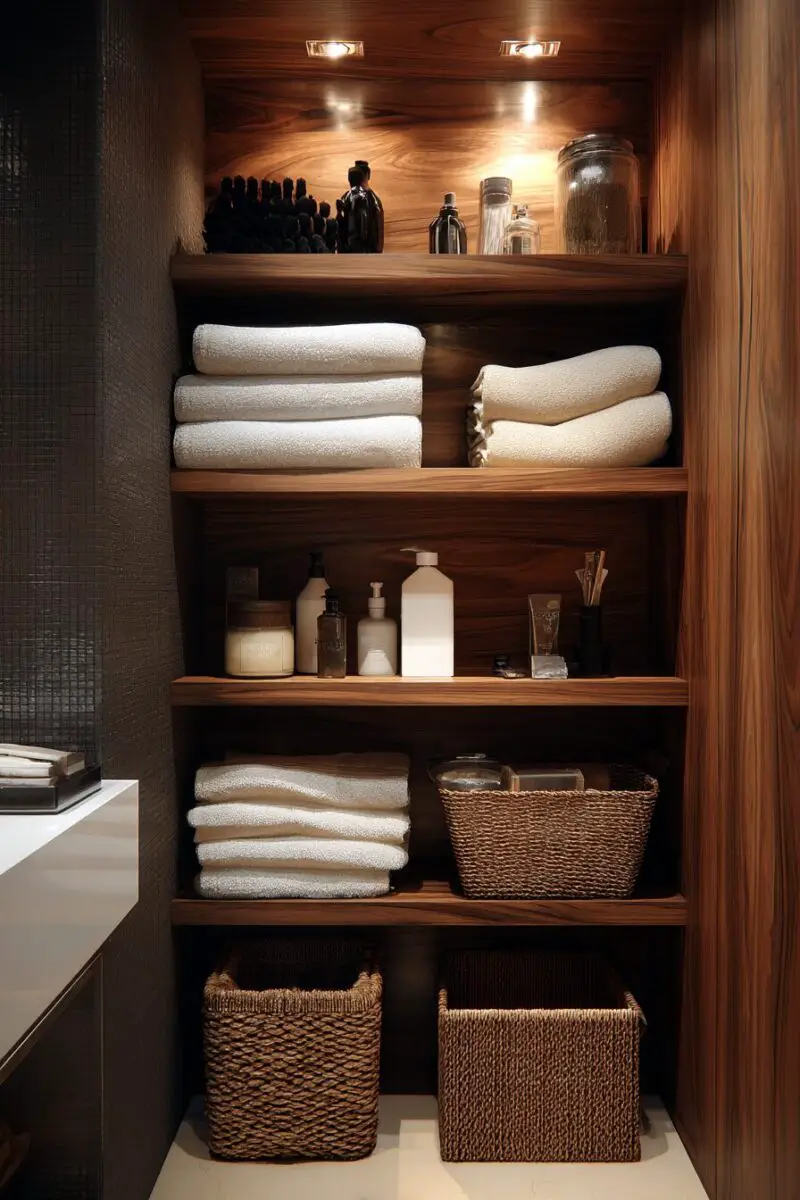
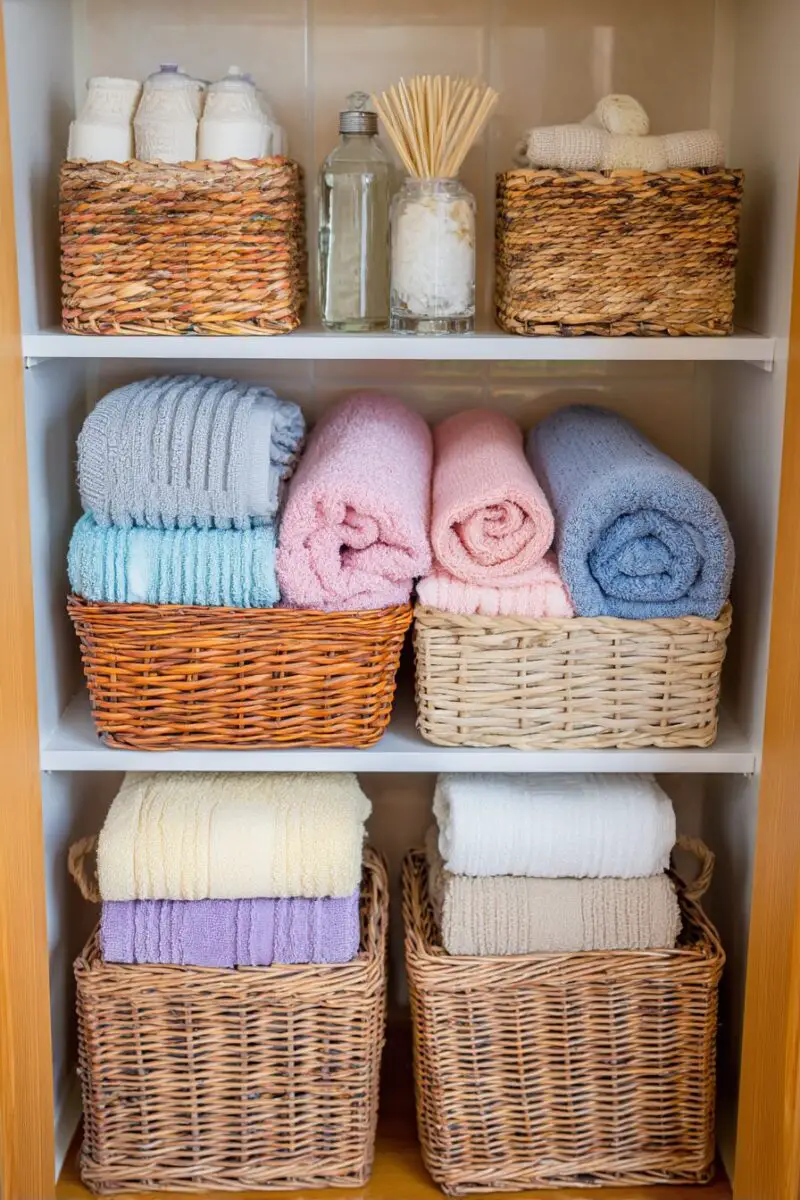
Your bathroom might just be the secret weapon in your decluttering journey.
Unlike other rooms packed with sentimental items and complex decisions, bathrooms contain mostly practical items with clear expiration dates.
You’ll know immediately whether that prescription from 2019 needs to go, and expired makeup practically screams “toss me!”
This room typically takes just 30-45 minutes to complete, giving you that instant gratification boost that makes tackling bigger spaces feel possible.
Start by clearing everything from your medicine cabinet and vanity drawers onto a clean towel.
Check expiration dates on medications, vitamins, and over-the-counter treatments – anything past its prime goes straight into a disposal bag.
Most medications shouldn’t go in regular trash, so contact your local pharmacy about safe disposal programs.
Cosmetics and skincare products also have shelf lives, even if they don’t show obvious expiration dates.
Mascara should be replaced every three months, liquid foundation every year, and powder products every two years.
If you can’t remember when you bought something, or if it smells off or has changed texture, it’s time to let it go.
Keep only the toiletries and beauty products you actually use regularly.
That expensive face cream you’ve been “saving for special occasions” should either become part of your daily routine or find a new home.
Your bathroom counter should only hold items you reach for daily – everything else can live in organized drawers or cabinets.
The key is creating a space where everything has a designated spot and you can find what you need without digging through clutter.
Once you experience the calm satisfaction of opening organized bathroom drawers, you’ll be motivated to bring that same peaceful feeling to other areas of your home.
TRENDING NOW
Effective Ways to Get Rid of Ants in Your HouseUse the One-Touch Rule to Stop Second-Guessing Yourself
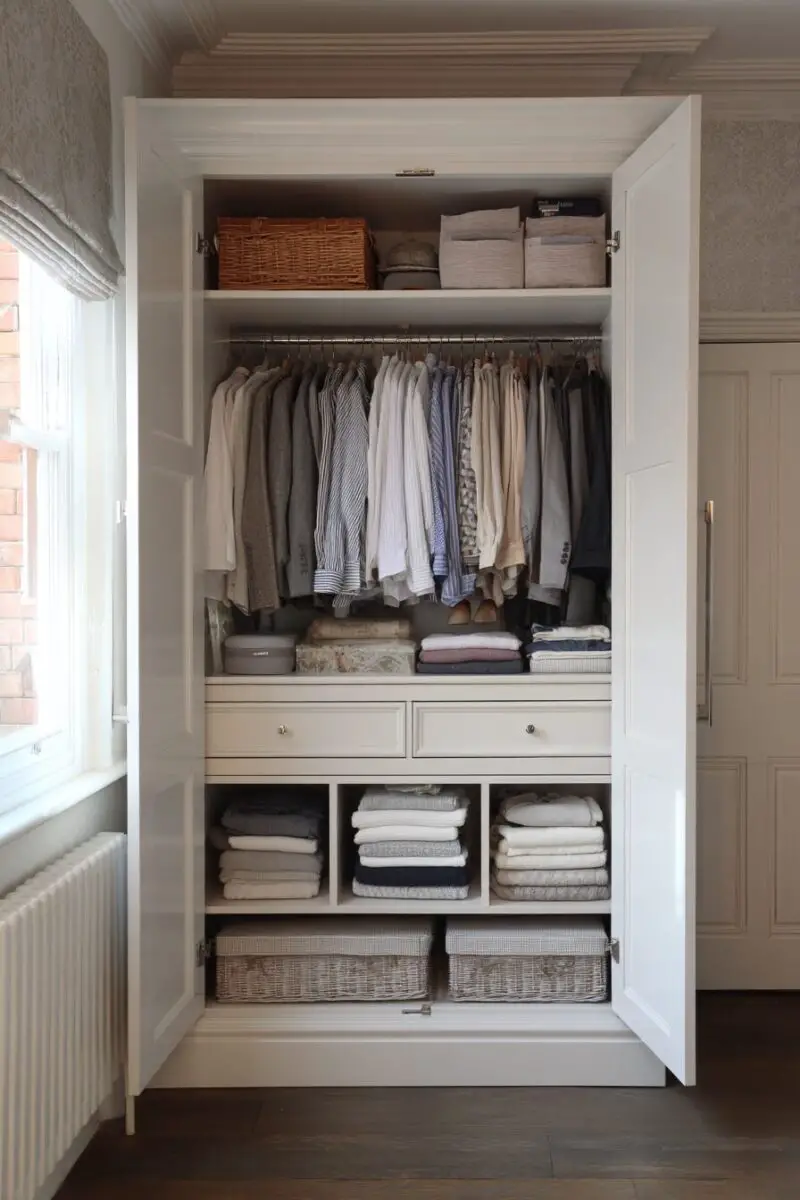
The one-touch rule will revolutionize how you make decluttering decisions.
Instead of picking up an item, thinking about it, setting it down, and coming back to it later, you commit to making a decision the moment you touch something.
This simple strategy eliminates the mental exhaustion that comes from revisiting the same items over and over again.
When you pick up that sweater you haven’t worn in three years, you immediately decide: keep, donate, or trash.
No putting it in a “maybe” pile to deal with later, no second-guessing yourself for the next hour.
The one-touch rule works because it prevents decision fatigue from building up throughout your decluttering session.
Every time you defer a decision, your brain uses energy cycling back to that unresolved choice.
By making quick, decisive moves, you preserve mental energy for the items that truly require more thoughtful consideration.
Trust your gut reaction when you first pick something up.
If your immediate thought is “I should probably get rid of this,” that instinct is usually right.
You’re not making irreversible life-altering decisions here – you’re simply choosing whether an object deserves space in your current life.
The items that genuinely belong in your life will feel obvious.
You’ll immediately know you want to keep your favorite reading glasses, your most comfortable pajamas, or the jacket that makes you feel confident.
For everything else, lean toward letting go rather than holding on.
Practice this rule with low-stakes items first, like old magazines or duplicate kitchen utensils.
As you build confidence in your quick decision-making, you’ll find it easier to apply the one-touch rule to more meaningful possessions.
Remember that keeping something “just in case” usually means it sits unused while taking up valuable space.
Your goal is creating a living environment filled only with items that actively contribute to your comfort, happiness, or daily functioning.
Design Your Dream Room in Minutes!
🏡 Start Creating FREE →Create Three Simple Piles: Keep, Donate, Trash
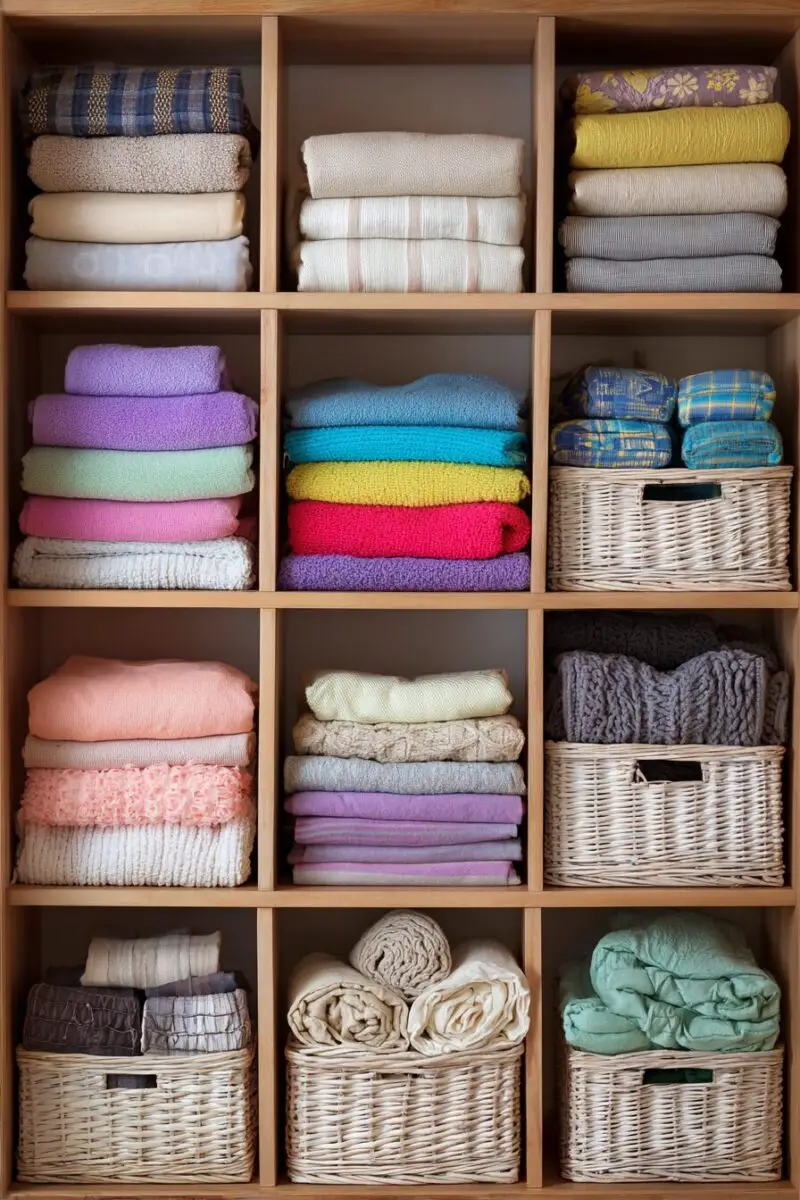
The three-pile system transforms overwhelming chaos into manageable categories.
Before you touch a single item, set up three distinct areas in your room: one for things you’re definitely keeping, one for items in good condition that others could use, and one for things that belong in the garbage.
Having these designated spaces ready prevents you from creating new clutter piles while you’re trying to eliminate existing ones.
Use large cardboard boxes, laundry baskets, or even different corners of the room to keep your categories clearly separated.
Label each area if it helps you stay focused, and resist the temptation to create additional categories like “maybe” or “decide later.”
Those extra piles defeat the purpose of this streamlined system.
Your “keep” pile should only contain items that you actively use, genuinely love, or need for safety and daily functioning.
This isn’t the place for things you might need someday or items you’re keeping purely out of guilt.
Be honest about whether each possession adds value to your current lifestyle.
The “donate” pile is for anything in good condition that no longer serves you but could benefit someone else.
This includes clothing that doesn’t fit, books you’ve already read, kitchen gadgets you never use, and electronics that still work but gather dust.
Knowing these items will help others makes it easier to let them go.
Your “trash” pile handles anything broken, damaged beyond repair, or simply worn out.
Don’t feel guilty about discarding things that have reached the end of their useful life – this is exactly what garbage is for.
As you work through your belongings, touch each item only once and immediately place it in the appropriate pile.
Avoid moving things between categories once you’ve made your initial decision.
This keeps you moving forward instead of getting stuck in endless reconsideration loops.
When you finish sorting, immediately bag up the trash pile and load donate items into your car for prompt delivery to a charity or donation center.
The faster you remove these items from your space, the less likely you are to retrieve something and create new clutter.
Tackle Safety Hazards First for Peace of Mind
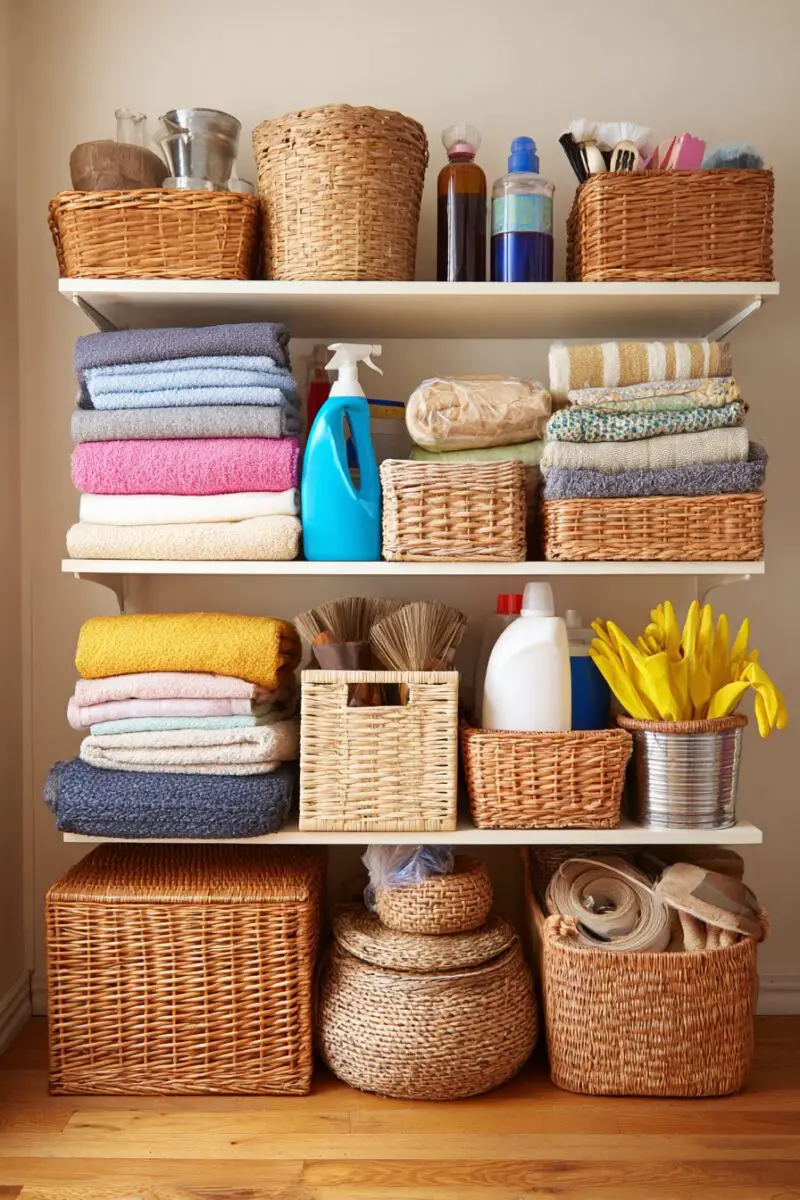
Safety hazards hiding in cluttered spaces pose real risks that increase with age.
Start your decluttering process by identifying and removing anything that could cause falls, fires, or health problems.
This approach not only makes your space immediately safer but also creates clear pathways that make the rest of your decluttering work easier and more manageable.
Look for items blocking walkways, stacked unsecurely, or creating tripping hazards.
Extension cords running across floors, loose rugs without non-slip backing, and boxes stacked too high all need immediate attention.
Remove these hazards completely or secure them properly before moving on to aesthetic decluttering decisions.
Check for fire risks like overloaded electrical outlets, old papers stored near heat sources, or damaged electrical cords.
Expired batteries can leak corrosive chemicals, so dispose of them properly at electronic recycling centers.
Old electronics that you’re not using should be unplugged and removed rather than left connected to power sources.
Pay special attention to stairs and frequently used pathways.
These areas should be completely clear of stored items, decorative objects that could be knocked over, or anything that requires you to step around or over it.
Your safety is more important than storing seasonal decorations in the hallway or keeping exercise equipment on the stairs.
Address lighting issues while you’re focusing on safety.
Remove items blocking lamps or windows that provide natural light.
Good lighting prevents accidents and makes spaces feel more open and welcoming.
Don’t forget about air quality and breathing hazards.
Old carpets, moldy items, dusty fabrics, and products with strong chemical odors should be removed from bedrooms and living areas.
If you discover items with mold, water damage, or pest infestations, address these issues immediately rather than trying to clean around them.
Creating a safe environment gives you a solid foundation for enjoying your newly organized space.
You’ll feel more confident moving around your home and more motivated to maintain the improvements you’re making.
Digitize Documents and Photos to Preserve Memories Without the Bulk
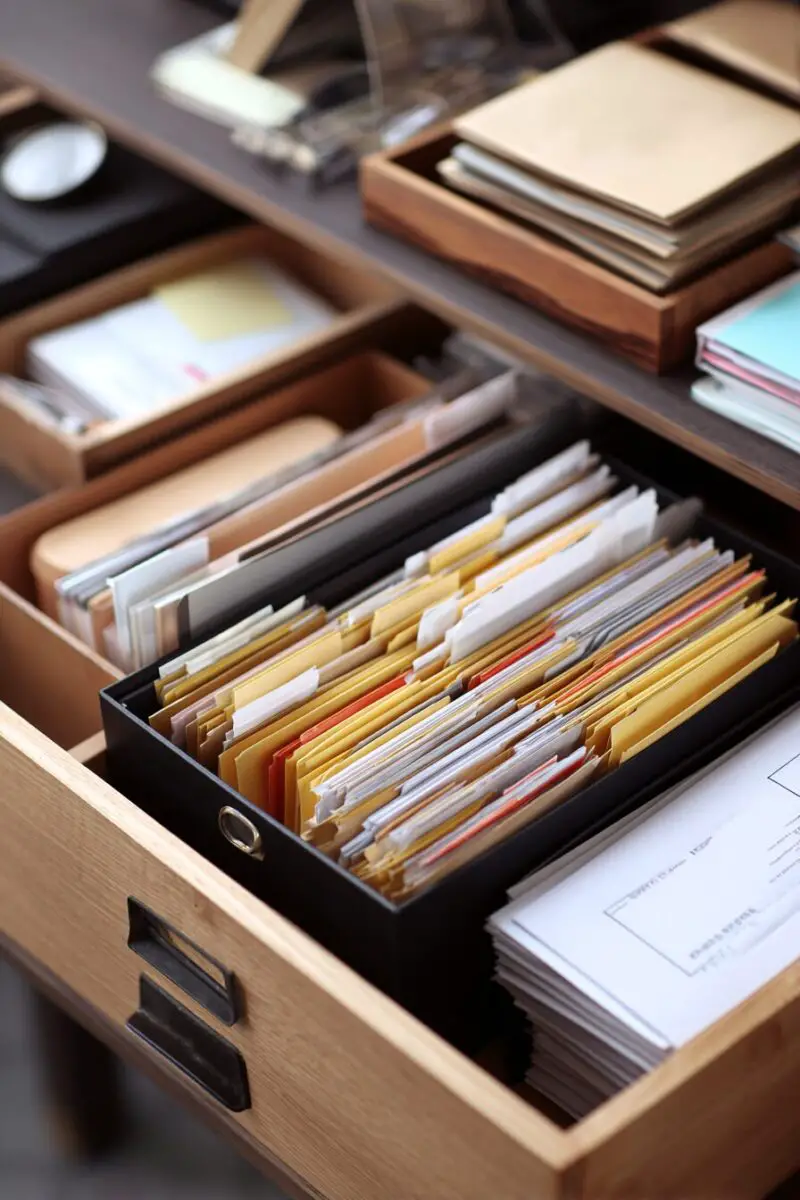
Physical documents and photo albums can quickly overwhelm storage spaces while holding precious memories and important information.
Converting these items to digital formats lets you preserve everything meaningful while dramatically reducing the physical footprint in your living space.
Modern smartphones make this process much simpler than you might expect, and the peace of mind from having backup copies is invaluable.
Start with important documents like insurance policies, medical records, tax returns, and legal papers.
Use your smartphone’s camera or a simple scanner app to create clear digital copies.
Store these files in organized folders on your computer or cloud storage service, and consider keeping backup copies in multiple locations.
Many banks and government agencies now prefer digital documents anyway, making this transition practical as well as space-saving.
For photographs, focus on images that truly matter to you rather than trying to digitize everything.
Sort through physical photos and select the ones that bring you joy or document important family moments.
You can scan these using smartphone apps designed specifically for photo digitization, which automatically adjust lighting and remove shadows for clear results.
This collaborative approach often reveals that multiple people have been storing identical photos, allowing everyone to keep just their favorites.
Sharing digital copies also ensures that precious family memories are preserved even if something happens to the original photos.
Once you’ve digitized important items, you can confidently recycle or dispose of the originals.
Keep only truly irreplaceable documents in physical form, like original birth certificates, passports, and certain legal papers that specifically require original signatures.
Everything else can exist quite happily in digital format while freeing up significant storage space.
Create a simple filing system on your computer or cloud storage that matches how you think about these items.
Folders labeled by year, family member, or document type work well for most people.
The goal is making digital files as easy to find as physical ones were to locate.
Ask Family Members to Help With Sentimental Items
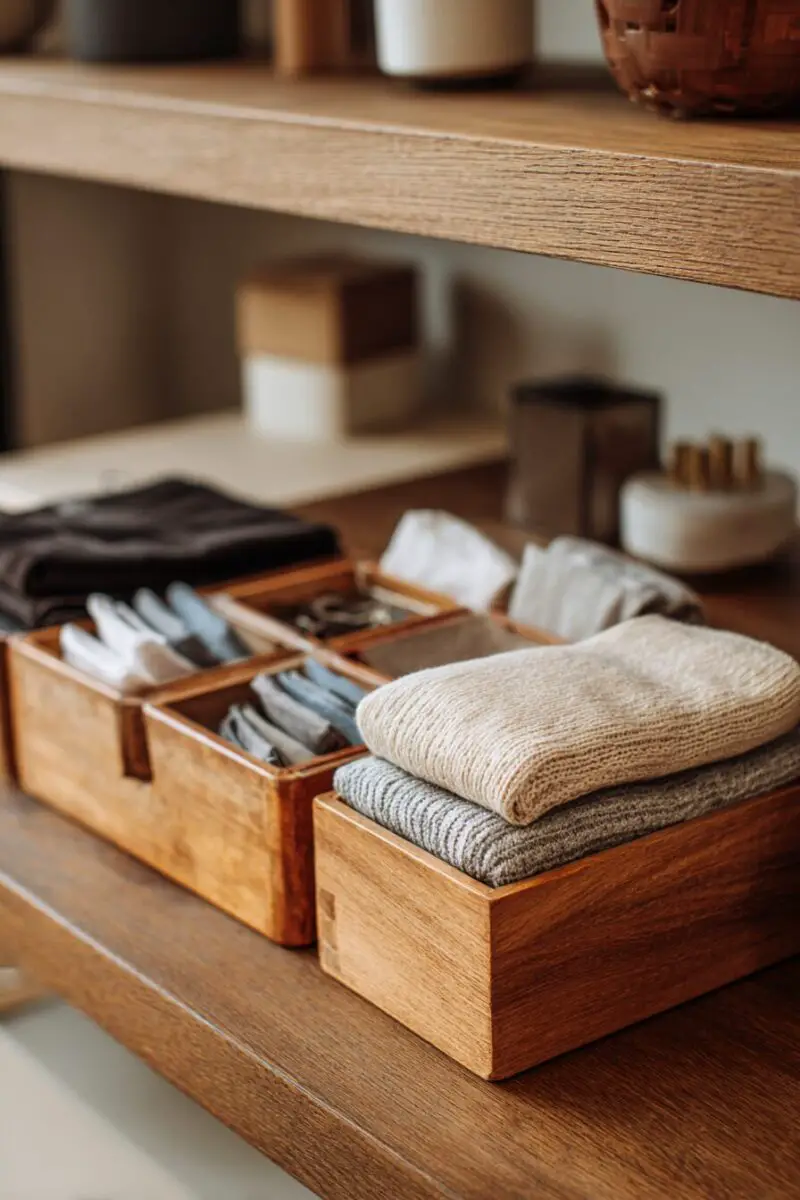
Sentimental items often create the biggest emotional roadblocks in decluttering because they connect us to people and memories we cherish.
Instead of struggling alone with these difficult decisions, invite family members to participate in the process.
They can offer perspective on which items truly honor shared memories and help you distinguish between meaningful keepsakes and objects you’re holding onto out of obligation.
Contact relatives before you begin sorting through inherited items, family photographs, or shared memorabilia.
Many families discover they’ve been unknowingly storing duplicate items because everyone felt responsible for preserving the same memories.
Your sister might already have mom’s recipe collection, or your cousin could be carefully storing identical holiday decorations.
Sharing the responsibility often means everyone can keep fewer items while ensuring nothing truly important gets lost.
Schedule a family gathering specifically for sorting through sentimental belongings together.
Make it a positive experience by sharing stories about the items you’re reviewing.
This storytelling process often reveals which objects spark genuine emotion and which ones you’ve been keeping simply because they once belonged to someone special.
Sometimes the stories matter more than the physical items themselves.
A picture of grandpa’s oversized armchair can preserve the memory without requiring you to find space for furniture that doesn’t fit your current lifestyle.
You might discover that what you really treasure is the memory of him sitting in that chair, not the chair itself.
Be open to creative solutions that honor memories in new ways.
That box of your mother’s jewelry might become a few carefully chosen pieces you actually wear rather than a complete collection gathering dust.
Your father’s extensive book collection could be donated to his favorite library with a memorial plaque rather than stored in boxes you never open.
Family members often have ideas for repurposing meaningful items in ways that keep memories alive while reducing storage needs.
Some relatives might want items you’re ready to release, creating a win-win situation where precious objects stay in the family but leave your space.
Remember that your relationship with family members exists independently of the objects you’ve inherited from them.
Apply the One-Year Rule to Clothing Decisions
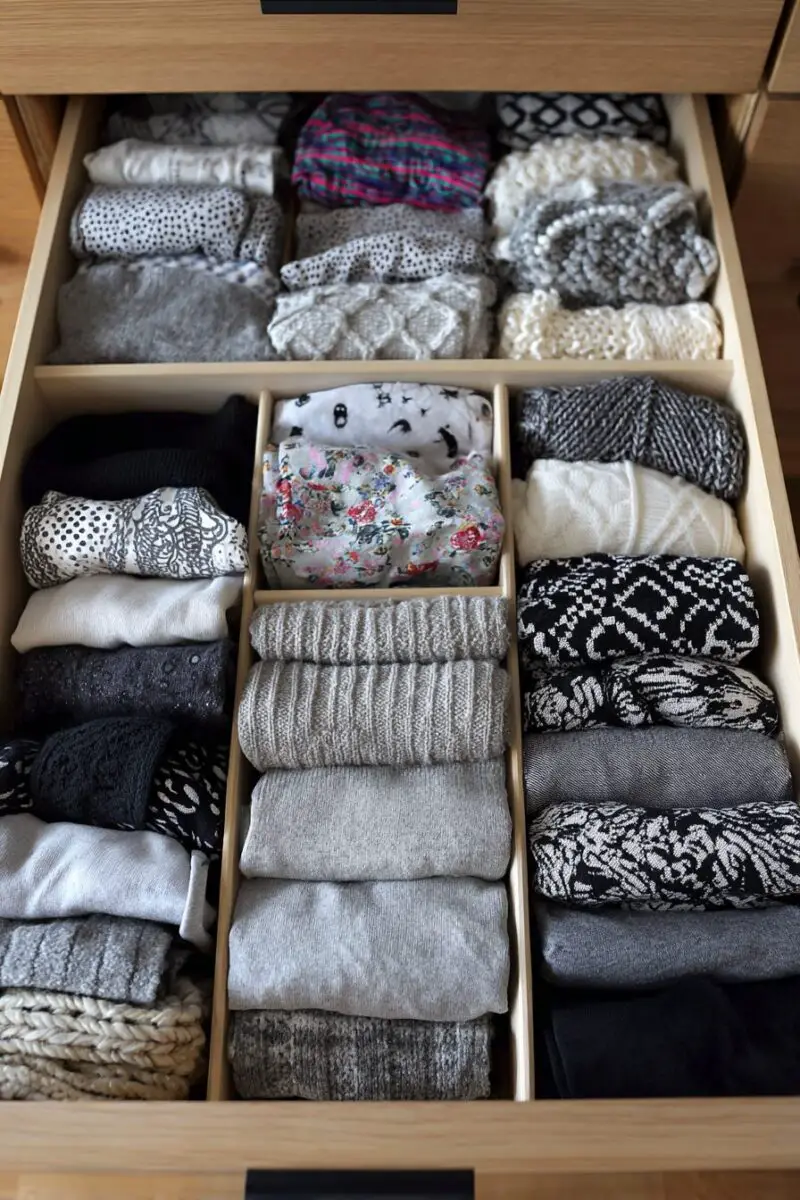
Clothing accumulates gradually until suddenly you realize your closet is bursting with items you never wear.
The one-year rule cuts through the complexity of fashion decisions with a simple standard: if you haven’t worn something in the past twelve months, you probably don’t need it taking up space in your wardrobe.
This timeline accounts for seasonal variations and special occasions while identifying items that no longer fit your lifestyle or preferences.
Start by turning all your hangers backwards in your closet.
As you wear items throughout the coming weeks, turn those hangers forward after putting clean clothes away.
After a month or two, you’ll clearly see which pieces you actually reach for and which ones remain untouched.
This visual system takes the guesswork out of identifying your real clothing preferences versus what you think you should wear.
Those formal business suits might have been essential five years ago, but if you’re now retired and prefer casual activities, they’re consuming valuable closet space without serving your actual needs.
Similarly, exercise clothes for activities you no longer pursue or hobby-related outfits for interests you’ve moved beyond can be released to make room for items you actually use.
Try on questionable items rather than just looking at them on hangers.
Clothing that doesn’t fit properly or feels uncomfortable will continue sitting unworn regardless of how much you paid for it originally.
Your body and preferences change over time, and your wardrobe should reflect who you are now rather than who you were in the past.
Focus on keeping pieces that make you feel confident and comfortable.
Quality basics that mix and match easily serve you better than specialty items that only work with specific outfits.
A smaller collection of clothes you genuinely like creates less decision fatigue when getting dressed and ensures everything in your closet earns its space.
Don’t forget accessories, shoes, and outerwear in this evaluation process.
Belts, scarves, jewelry, and handbags follow the same one-year principle.
Shoes that hurt your feet or bags that don’t suit your current needs should join the donation pile regardless of their original cost.
Your goal is creating a wardrobe that actively supports your daily life rather than storing a museum of past fashion choices.
Focus on One Small Area at a Time to Avoid Overwhelm
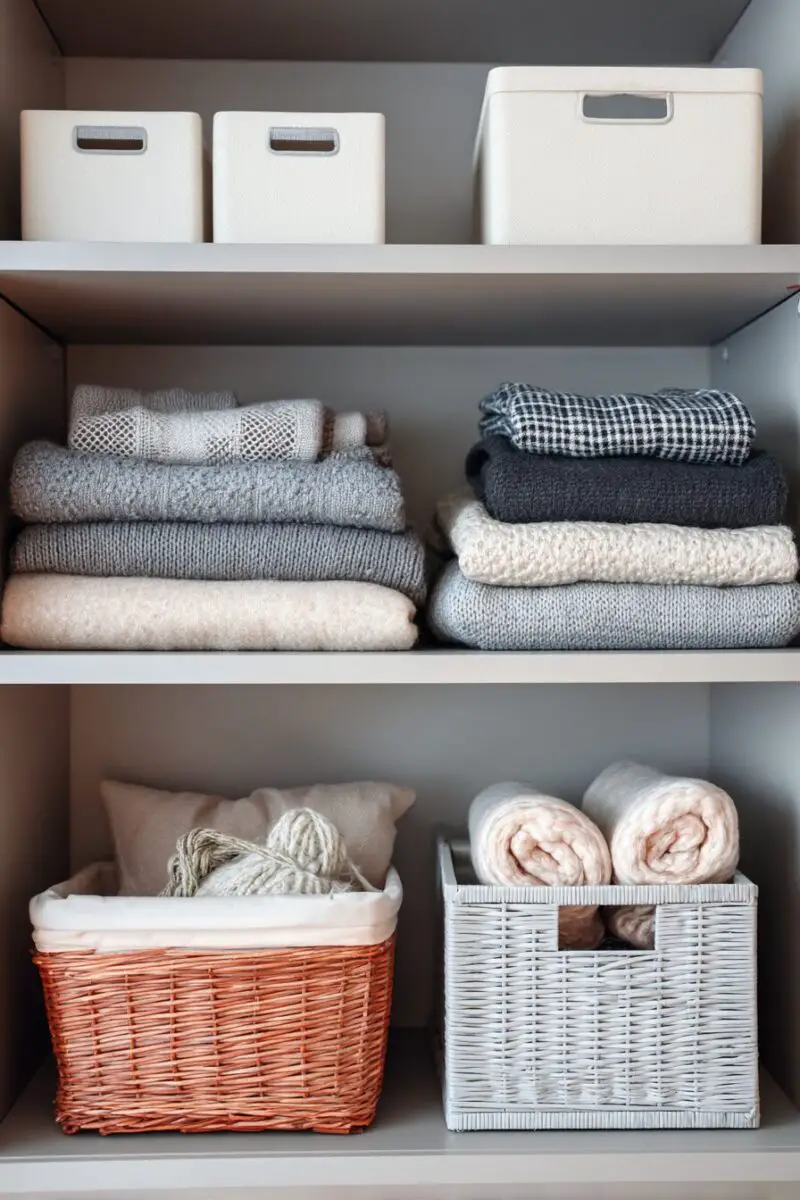
Attempting to declutter an entire room in one session often leads to frustration and abandonment of the whole project.
Instead of tackling everything at once, choose one specific, manageable area that you can complete successfully in 30-60 minutes.
This approach builds momentum and confidence while creating visible progress that motivates you to continue with the next small section.
Start with a single drawer, one shelf, or even just the top of your nightstand.
These contained spaces have clear boundaries that prevent the project from expanding beyond your energy level.
Successfully completing a small area gives you a sense of accomplishment and lets you practice your decision-making skills on a manageable scale.
Choose areas that will have immediate impact on your daily routine.
Clearing out your bedside table drawer means you’ll notice the improvement every morning and evening.
Organizing your bathroom medicine cabinet affects your routine multiple times per day.
These frequently used spaces provide constant positive reinforcement for your decluttering efforts.
Set a timer for your chosen timeframe and commit to working only in your designated area.
When the timer goes off, stop working even if you feel motivated to continue.
This boundary prevents decluttering from becoming an exhausting marathon that leaves you dreading the next session.
Knowing you’ll only work for a limited time makes it easier to start and helps maintain your energy for future sessions.
Complete each small area entirely before moving to the next one.
This means removing items you’re discarding, returning “keep” items to their proper homes, and wiping down or organizing the newly cleared space.
Leaving half-finished areas creates visual chaos that undermines your progress and makes you feel like you’re not making real headway.
Take a photo of each completed area to document your progress.
These before-and-after images provide tangible proof of your accomplishments and can motivate you on days when the overall project feels overwhelming.
You’ll be surprised how much difference these small improvements make to the overall feel of your room.
Schedule regular short sessions rather than waiting for large blocks of free time.
Fifteen minutes every few days accomplishes more than waiting for a free weekend that never comes.
Consistency beats intensity when it comes to sustainable decluttering progress.
Evaluate Each Item’s Current Functionality in Your Life
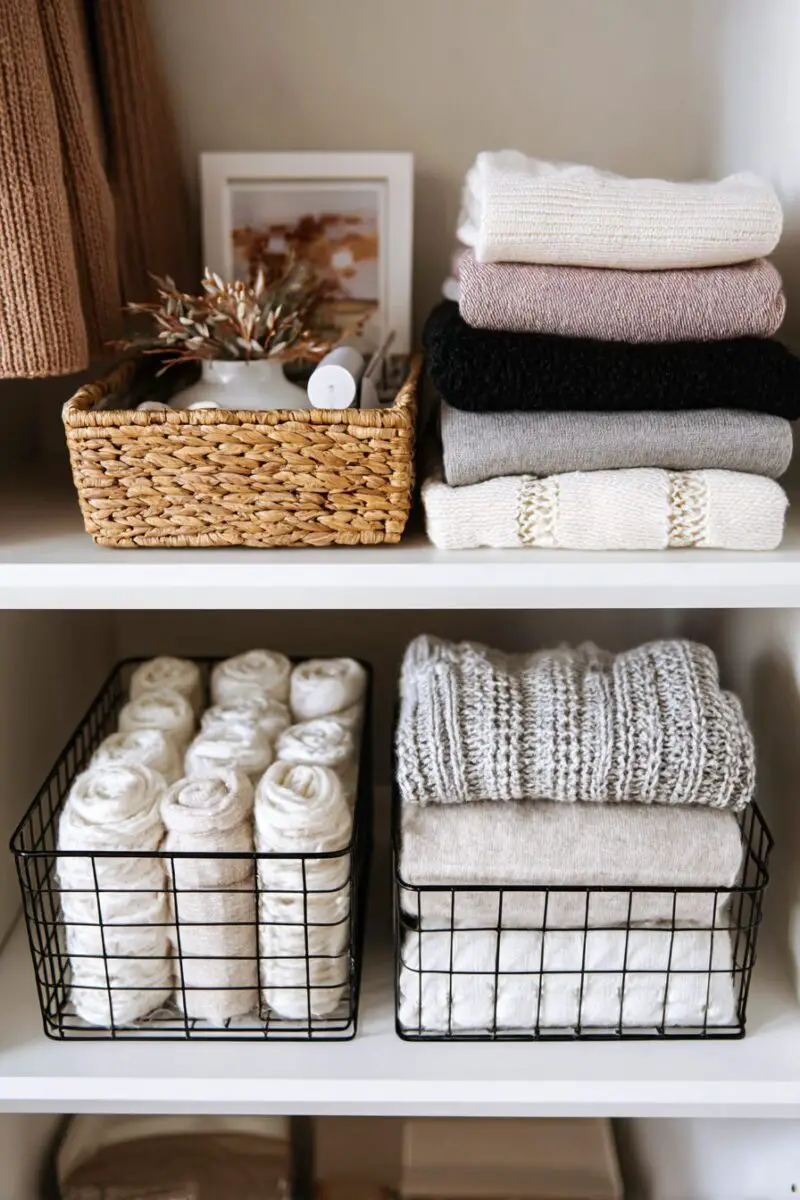
The most honest decluttering question isn’t “Do I like this?” but “Does this actually function in my life right now?”
Many items we hold onto served important purposes in the past or might theoretically be useful someday, but they’re not contributing anything to our current daily experience.
Shifting your focus to present-day functionality helps you make clearer decisions about what deserves space in your home.
Consider each item’s practical role in your current routine.
That bread maker seemed like a great idea when you bought it, but if you’ve been purchasing bread from the store for the past two years, it’s not functioning as intended in your life.
Exercise equipment gathering dust isn’t functioning as fitness gear – it’s functioning as an expensive clothes rack and guilt trigger.
Be honest about these realities rather than holding onto items based on good intentions.
Ask yourself when you last used each item and whether you have realistic plans to use it again soon.
Kitchen gadgets, hobby supplies, and electronic devices are particularly prone to becoming non-functional clutter.
If you can’t remember the last time you used something or have to think hard about potential future uses, it’s probably not earning its storage space.
You might discover you’re keeping three different tools that do essentially the same job, or that your smartphone has replaced several single-purpose devices.
Consolidating functions reduces clutter while maintaining all the capabilities you actually need.
Think about maintenance requirements versus actual usage.
Items that require regular care, cleaning, or upkeep should provide enough value to justify that ongoing effort.
If you’re avoiding using something because it’s too much trouble to maintain, it’s not truly functional in your lifestyle.
Evaluate whether items fit your current physical abilities and living situation.
Furniture that’s too heavy to move safely, tools that require strength you no longer have, or equipment designed for spaces larger than your current home aren’t functional regardless of their potential utility.
Your possessions should support your life as it is now, not as it once was or as you imagine it might become.
Focus on keeping items that actively make your daily routines easier, more comfortable, or more enjoyable.
Everything else is taking up space that could be used for things that truly enhance your current lifestyle.
Celebrate Small Wins to Maintain Your Momentum
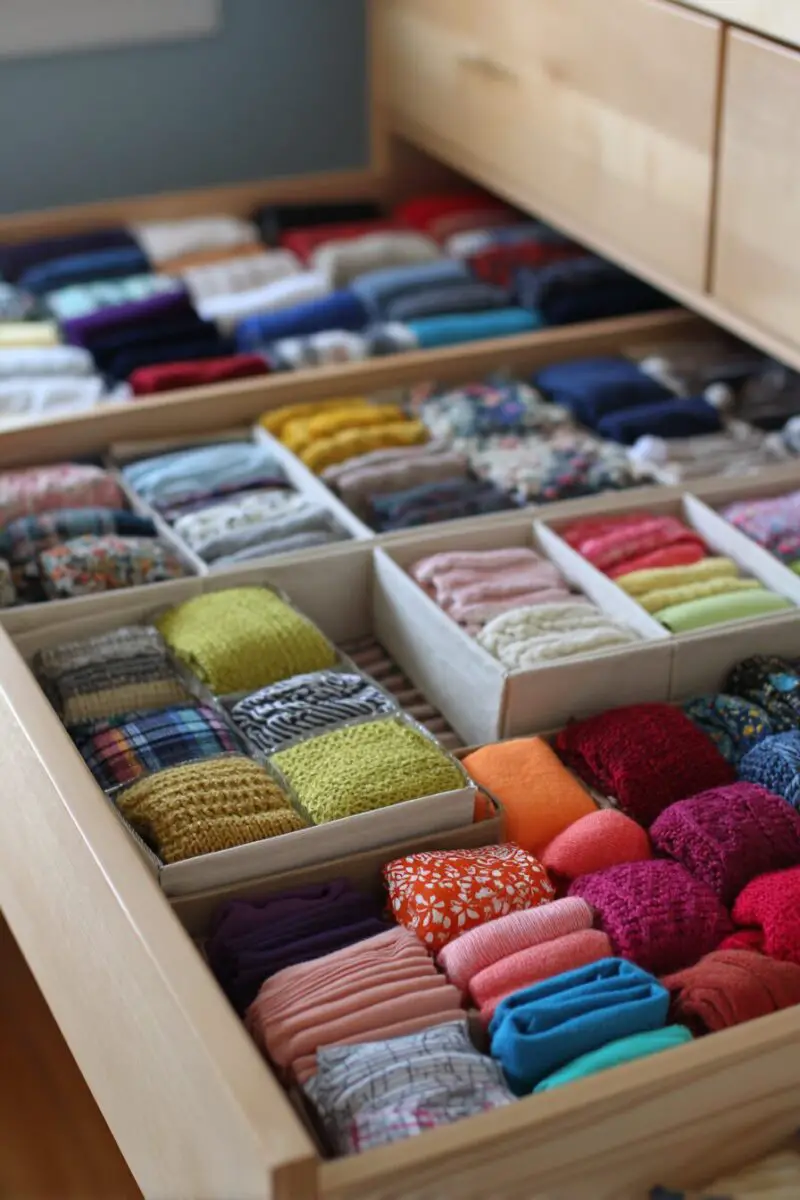
Decluttering represents a significant life change that deserves recognition and celebration along the way.
Acknowledging your progress helps maintain motivation during challenging moments and reinforces the positive feelings associated with your newly organized spaces.
Small celebrations make the entire process more enjoyable and sustainable rather than treating it as pure drudgery to endure.
Take a moment to appreciate each completed area before rushing on to the next task.
Sit in your newly organized bedroom and notice how much calmer it feels.
Enjoy opening a drawer that now contains only items you actually use and can easily find.
These pause-and-appreciate moments help your brain register the benefits of your hard work.
Share your progress with supportive friends or family members who understand your goals.
Photos of your before-and-after spaces can illustrate dramatic improvements that might not be obvious to you since you’ve been working gradually.
Outside perspectives often highlight accomplishments that feel routine to you by this point in the process.
Treat yourself to something special when you complete major milestones.
This might be as simple as your favorite coffee drink after clearing out a closet, or a nice dinner out after finishing an entire room.
The key is connecting positive experiences with your decluttering achievements so your brain associates this work with reward rather than sacrifice.
Consider small upgrades that highlight your newly organized spaces.
Fresh flowers for a cleared dining table, new drawer organizers for your simplified desk, or attractive storage containers for items you’re keeping can enhance the visual impact of your work.
These investments in your organized space demonstrate commitment to maintaining your progress.
Keep track of the practical benefits you’re experiencing from your efforts.
Maybe you’re sleeping better in a clutter-free bedroom, cooking more often in an organized kitchen, or feeling less stressed when getting dressed in a streamlined closet.
Documenting these quality-of-life improvements reminds you why the work is worthwhile.
Plan a special activity to enjoy in your newly organized space.
Invite friends over to see your improved living room, start a new hobby at your cleared craft table, or simply read a book in your peaceful bedroom.
Using and enjoying your organized spaces reinforces the value of maintaining them.
Remember that decluttering is an act of self-care that creates a more supportive living environment for your future self.
Decluttering your living space is really about creating room for the life you want to live right now.
Each item you remove makes space for peace, functionality, and the things that truly matter to you.
Start with just one small area today, and remember that every single item you release is a step toward a home that supports your happiness and well-being rather than overwhelming you with maintenance and decisions.

